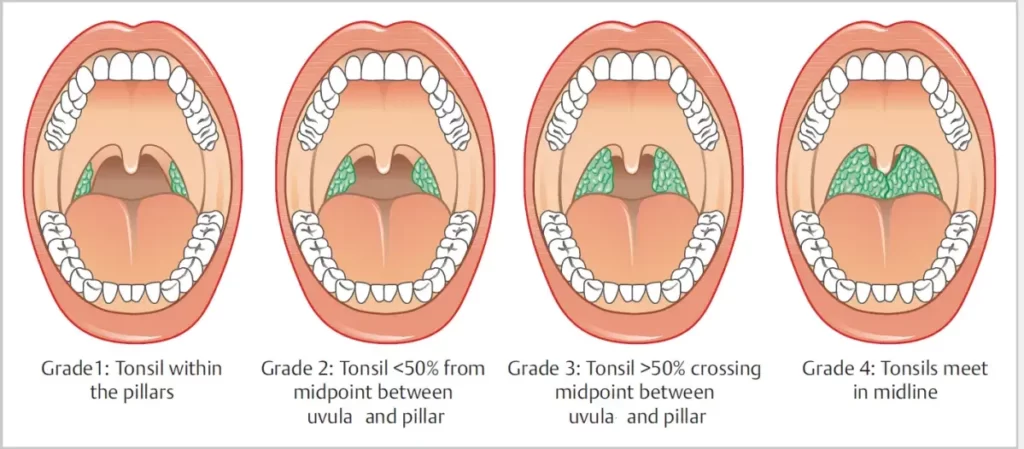The Tonsil Grading Scale: A Mystery Decoded

Medically Reviewed By:
Dr Leslie Koh
M.B;B.S. (Singapore), MRCS (ENT) Edinburgh, M. Med (ORL), FAMS
Tonsil grading is a crucial diagnostic tool used to evaluate the severity of tonsil enlargement. It plays a significant role in determining appropriate treatment options and understanding potential underlying conditions. In this article, we will delve into the concept of tonsil grading, its relevance in medical practice, and address common queries related to this topic. So, let’s embark on this journey to comprehend the world of tonsil grading and its implications.
The Significance Of Tonsil Grading
Tonsil grading is an essential aspect of diagnosing and managing conditions that affect the tonsils. By assessing the size and condition of the tonsils, medical professionals can gauge the severity of tonsil enlargement and make informed decisions regarding treatment. Let’s explore why tonsil grading is so important:
Evaluating Tonsil Enlargement
Tonsil grading provides an objective measurement of tonsil size, allowing healthcare providers to assess the extent of enlargement accurately. This information helps determine whether the enlargement is within normal limits or indicative of an underlying issue.
Identifying Potential Obstruction
Enlarged tonsils can obstruct the airway and cause breathing difficulties, particularly during sleep. Tonsil grading helps identify the degree of obstruction and guides appropriate intervention, such as surgical removal of the tonsils (tonsillectomy).
Assessing Recurrent Infections
Recurrent tonsil infections, known as tonsillitis, can cause throat pain and significantly impact an individual’s quality of life. By grading the tonsils, healthcare professionals can evaluate the frequency and severity of infections, enabling them to recommend suitable treatment options.

Understanding The Tonsil Grading Scale

Tonsil grading involves a systematic evaluation of the tonsils’ size, based on specific criteria. The grading system may vary among healthcare professionals, but generally, it follows a scale from 0 to IV. Let’s explore the typical grading criteria:
Grade 0: Previous Tonsillectomy
In Grade 0, the tonsils have been previously removed surgically and are no longer present.
Grade I: Normal Size
In Grade I, the tonsils are within the normal range. They are not significantly enlarged and do not obstruct the throat or airway.
Grade II: Mild Enlargement
Grade II indicates mild enlargement of the tonsils. They may be slightly larger than normal but do not cause significant obstruction or discomfort.
Grade III: Moderate Enlargement
In Grade III, the tonsils are moderately enlarged. They may partially obstruct the throat or airway, leading to symptoms such as snoring or difficulty swallowing.
Grade IV: Severe Enlargement
Grade IV represents severe enlargement of the tonsils. They significantly obstruct the throat or airway, causing substantial breathing difficulties, sleep disturbances, and swallowing problems.
Conclusion
Tonsil grading plays a vital role in assessing the severity of tonsil enlargement and guiding treatment decisions. By objectively evaluating the size and condition of the tonsils, healthcare professionals can identify potential obstructions, recurrent infections, and underlying conditions. Understanding tonsil grading empowers individuals to make informed decisions regarding their health and seek appropriate medical intervention when necessary.
By recognizing the significance of tonsil grading and its implications, individuals can take proactive steps to address any issues related to tonsil enlargement. Regular check-ups and consultations with healthcare professionals are recommended to monitor tonsil health and ensure timely interventions, if required.
Frequently Asked Questions
What Is The Purpose Of Tonsil Grading?
Tonsil grading helps healthcare professionals assess the severity of tonsil enlargement and determine appropriate treatment options based on objective measurements.
Is Tonsil Grading Painful?
No, tonsil grading itself is not painful. It involves visually evaluating the size and condition of the tonsils using a grading scale.
What Are The Indications For Tonsillectomy Based On The Tonsil Grading Scale?
Tonsillectomy, the surgical removal of the tonsils, may be recommended based on the severity of tonsil enlargement. Higher grades, such as Grade III or Grade IV, along with associated symptoms like recurrent infections or obstructive sleep apnea, are common indications for tonsillectomy.
Can Tonsil Grading Help Diagnose Underlying Conditions?
Using the tonsil grading scale can provide insights into potential underlying conditions. For example, significantly enlarged tonsils, especially in Grade IV, can be indicative of conditions such as tonsillar hypertrophy or infectious mononucleosis. Tonsil grading assists in identifying such conditions and guiding further investigations if necessary.
Is Tonsil Grading Applicable To Adults As Well?
Tonsil grading is not limited to children and is applicable to adults as well. Enlarged tonsils can occur at any age, and may require evaluation using the grading system to determine the severity and appropriate management.
Disclaimer:
The information, including but not limited to, text, graphics, images and other material contained on this website are for informational purposes only. No material on this site is intended to be a substitute for professional medical advice, diagnosis or treatment. Always seek the advice of your doctor or other qualified health care provider with any questions you may have regarding a medical condition, treatment or medication and before undertaking a new health care regimen, and never disregard professional medical advice or delay in seeking it because of something you have read on this website. If you think you may have a medical emergency, call 995 or visit the nearest Emergency Department immediately. No doctor-patient relationship is created by this website or its use. Neither the owner of the website, nor its employees, or any contributor to this web site, makes any representations, express or implied, with respect to the information provided herein or to its use.
References:
Standardized Grading Of Tonsil Size – UpToDate
Standardized Grading Of Tonsil Size

